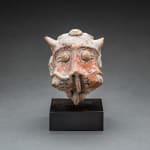Hellenistic Terracotta Feline Head, 300 BCE - 100 BCE
Terracotta
10.2 x 8.9 cm
4 x 3 1/2 in
4 x 3 1/2 in
OF.248
Further images
A stunning Hellenistic feline protome in terracotta. These finely moulded figures, often highly decorated, rose in popularity during the 4th and 3rd centuries BCE. The Hellenistic period was characterized by...
A stunning Hellenistic feline protome in terracotta. These finely moulded figures, often highly decorated, rose in popularity during the 4th and 3rd centuries BCE. The Hellenistic period was characterized by great transformation. Many artistic changes took place during this time, with the Hellenistic period being defined by more drama, emotion and decoration. Craftsmen also began creating pottery that matched the opulence of the new ruling class.
The term Hellenistic refers to the expansion of Greek imperialism following the death of Alexander the Great in 323 BC, followed by the Roman conquest consequentially usurped by Ptolemaic Egypt in 31 BCE following the Battle of Actium. Art from this period encompasses numerous regions and cultures often put under the heading of "Hellenistic Art" for convenience. As the human body was both secular and sacred, with the greeks seeing their gods as anthropomorphic, the representation of the human body was the most important subject for artistic endeavour during this period, and sculpture shifted towards increasing naturalism.
The term Hellenistic refers to the expansion of Greek imperialism following the death of Alexander the Great in 323 BC, followed by the Roman conquest consequentially usurped by Ptolemaic Egypt in 31 BCE following the Battle of Actium. Art from this period encompasses numerous regions and cultures often put under the heading of "Hellenistic Art" for convenience. As the human body was both secular and sacred, with the greeks seeing their gods as anthropomorphic, the representation of the human body was the most important subject for artistic endeavour during this period, and sculpture shifted towards increasing naturalism.





